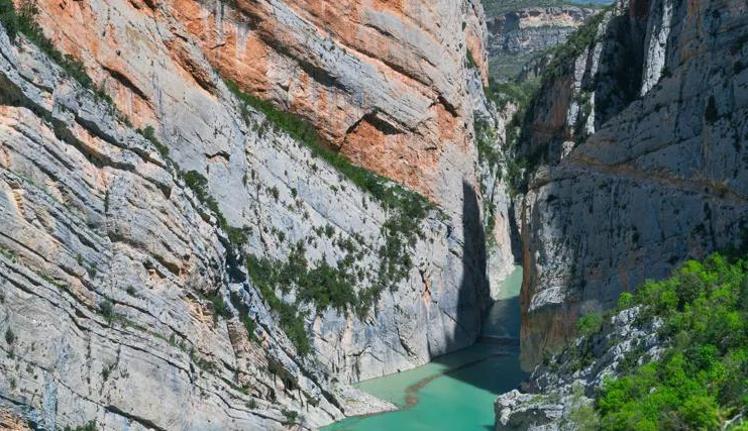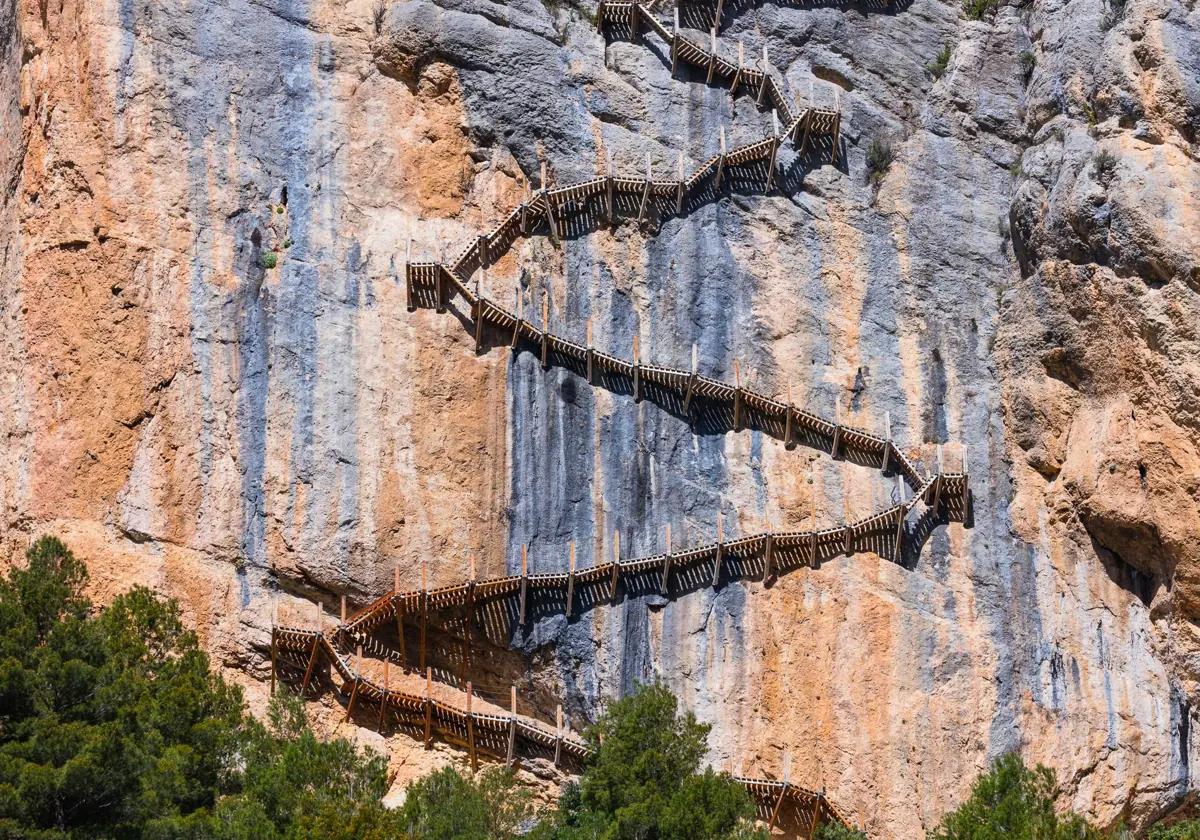Do you have a head for heights? This is the imposing zigzagging walkway clinging to a vertical rock face in Spain
Montfalcó's walkways footpaths that overlook Noguera Ribagorzana river, on the border between Huesca and Lérida, set quite a benchmark for active tourism
Mar Ramírez
Huesca
Tuesday, 7 May 2024, 23:35
You only need to be a lover of hiking and have the desire to enjoy the most extraordinary views to feel an irresistible desire to walk along the footbridges that make some of Huesca's mountain landscapes so unique.
Trails with views, suspension bridges and footbridges clinging to the rocky, mountain walls can be found in three locations in Huesca. There is one next door to the beautiful village of Alquézar , in Somontano de Barbastro. Or head to the striking mountain scenery of Alto Gállego where you can walk along the recently-opened footbridge of Panticosa. Last, but not least, you can amble along the walkway of Montfalcó (literally meaning Falcon Mountain), overlooking Mont Rebei gorge, the borderline to the lands of Lleida.
In the easternmost part of the province of Huesca the uninhabited village of Montfalcó (a ghost village since 1960) is the starting point for reaching the footbridges of the same name.
Overlooking the Noguera Ribagorzana river, the Montfalcó footbridges are the first section of the traditional bridlepath that the locals used to use to reach Puebla de Montañana, a village located to the north of the river. To do so, they had to overcome an imposing obstacle, the Mont Rebei gorge and congost (the river basin flowing out of the narrow gorge). No other means of transport was capable of getting over this obstacle.
In this narrow gorge of orangey-red limestone walls many griffon vultures nest. Other iconic birds of prey such as golden eagles, bearded vultures, peregrine falcons and Egyptian vultures can also be seen. The gorge forms a magnificent, natural border between Aragon and Catalonia thanks to the river that crosses the Montsec mountain range.
The narrow passage is a challenge that can be tackled in different ways, but always in search of exceptional views. One possible route is to follow the course of the Noguera Ribagorzana river as it backs up into Canelles reservoir aboard a canoe or an electric-powered boat. The imposing perspective provided by the reddish walls, barely twenty metres apart as they rise above the wayward flow of the river, hits you straight in the eye from the starting point.
Although the route from the bottom of the gorge through the emerald green waters of the river is impressive, it is the access to the vertical footpath that offers the most thrilling experience for any hiker.
The rocky road
This route starts in the unoccupied village of Montfalcó. Located in the Huesca region of La Ribagorza, it is a village nestled in the mountains from where the well-signposted route starts. The trail leads downhill to the village fountain, next to which you can see the old, open-air washroom. The restored shrine of Santa Quiteria and San Bonifacio, one of the jewels of Aragonese Romanesque art, has stuck out on a rocky outcrop since the 11th century.
Trail
-
Distance: 4 km one way. Medium difficulty. Two hours duration.
-
Elevation: Montfalcó (780 m) and Puebla de Montañana (510 m).
-
Overnight stay: Montfalcó hostel. (www.alberguemontfalco.com). Monastery of Les Avellanes near Os de Balaguer, Noguera, Lérida (www.monestirdelesavellanes.com). Quiet monastic complex declared an historic-artistic site with tourist accommodation.
Along the way, in addition to the views that open up before our eyes, we can also get to know the fauna and flora of the area thanks to illustrated, information boards.

The path continues downhill, crossing the Tartera ravine, which gives the walker their first sighting in the distance of the starting section of footbridges anchored into the rock face. The thrills soon start as you head up the steps and ramps, helped only by the metal cable 'handrail' that separates the walkway from the emptiness of the gorge. The gorge can also be glimpsed through the planks as you walk along the two stretches of footbridges - can you measure up to the task? You climb up one by one as the walkway is only wide enough for one person, so there is no option to back down once you have started up the 291 steps that span the 83-metre drop of the gorge wall.
A new ravine, Sigüe, is where the hiker can set foot once more on terra firma after the steep descent, and this leads to the 35-metre-long metal suspension bridge. The bridge affords exceptional views of the gorge, suspended over the same spot where the original bridge between both villages used to be. That was their former crossing and was destroyed when the reservoir was built in 1960.
As soon as you cross the bridge, which can bring on some vertigo as its metal platform stretches somewhat shakily over the river, you will be on the Catalan side of this historic trail. This is the moment when you get deep into the gorge and follow it just 50 metres above the water in a northerly direction, crossing tunnels carved into the rock, plenty of viewpoints and even benches where you can rest and enjoy the splendid views until you reach Hondoravine. This is where a new 40-metre bridge crosses over to Masieta, an old farmhouse now converted into an information point and the starting point for taking the Montfalcó trail in reverse.
For those who do not want to suffer from vertigo, an alternative hiking route starts in Corça (Lérida) until it joins the path coming from Montfalcó at the metal bridge. En route you have views overlooking the entrance to the gorge, plus the opportunity to see the church of Mare de Deu de La Pertusa, a small Romanesque chapel next to the remains of a castle that dominates the most picturesque and panoramic view of the gorge.
